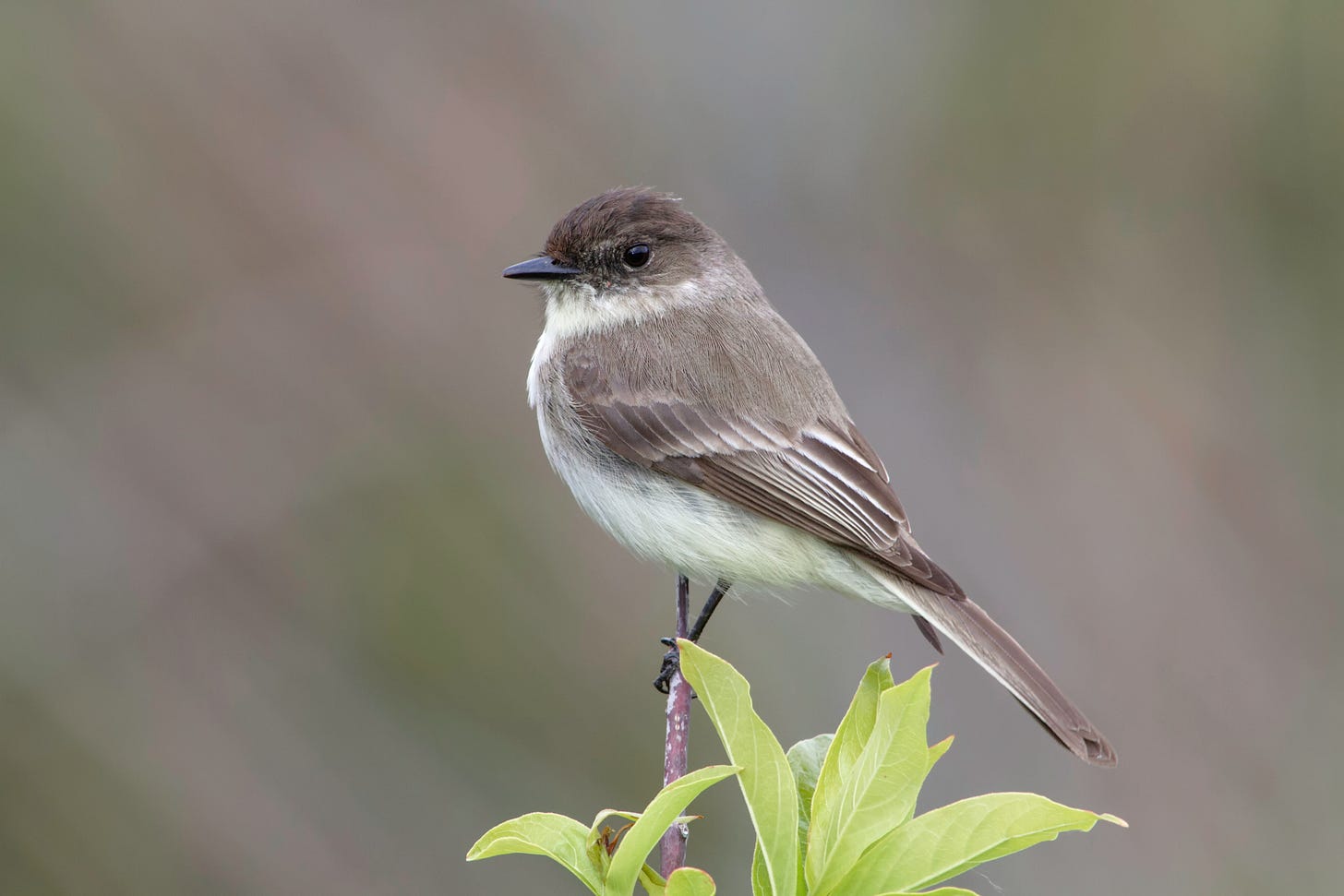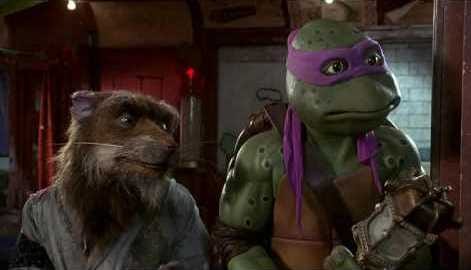#12: APRIL '24
In which we upturn runny noses to glimpse first waves of migrating birds then promptly dive headfirst into a hole. (Latter is for knowledge seeking, not earthquake safety.)
Hello! Welcome back. How are y—
SORRY. ‘SCUSE US. Imma let you finish but WE’RE NOT GREAT … Okay in most senses, we’re good. The air warms in fits and starts. We’re spring feverish, sniffling over sun-dappled smiles. And in this newsletter we’re excited to present, for the first time ever, THE 22 WARBLERS OF MCGOLRICK PARK.

BUT WE’RE ALSO KIND OF NOT FINE. We have to be honest and apologize. The truth: noticing nature, while having the primary effect of improving nearly everything, has the secondary effect of begetting … rage. Rage against pollution. Rage against development. Rage against —gulp— humanity. So, sorry. And also, welcome. Welcome to The Rathole. More below (where we bury tough feelings). But before that:
Please like and share this newsletter. It’s because of readers like you that The Noticer’s Monthly exists. So thanks warmly!
UPDATES & ANNOUNCEMENTS
Brittany Radocha (a.k.a. B-Radical, a.k.a. your new favorite person) and Parsley Steinwiess (a.k.a. P-sizzle, a.k.a. P-slay, a.k.a. your other new favorite person) will lead tomorrow’s walk. Michael’s back next week.
Last newsletter we taught you to use iNaturalist. From April 26 - 29, for the City Nature Challenge, turn your tweeter fingers into Demeter fingers and log as many McGolrick Park specimens as you can. Biggest MBC contributor gets a prize.
We’re very likely gonna break this newsletter up into a bi-weekly or equivalent next month. Like: frequent recaps here, monthly long-forms there. Cool? Cool.
Just a few US made oversized long-sleeve tees left. DM us.
MARCH: LA RÉTROSPECTIVE
33 bird species noticed in McGolrick last month. Full list & favorites here.
Eastern Phoebes seen in McGolrick for the first time since October.
We did our free Saturday walk thing. Four times. Featuring—
Warbler Lessons! How ‘bout them baddies Hayley (aka puppysmalll) and Madeline (aka madelinemargarethe)? Who soared through their warbler gauntlets like migrant birds do windowless skies. Both were awarded a ticket to this Sunday’s Nonhuman Teachers event: Ecological Storytelling, feat. author Susan Orlean in conversation with New Yorker writer Naomi Fry.
Saturday birds: Downy Woodpecker · Yellow-bellied Sapsucker · Northern Flicker · White-throated Sparrow · Red-bellied Woodpecker · American Kestrel · Blue Jay · Herring Gull · Common Grackle · Northern Cardinal · Song Sparrow · American Crow · Rock Pigeon · American Robin · House Sparrow · European Starling · Mourning Dove · Northern Mockingbird
WHAT TO NOTICE IN APRIL
While May proper is prime Spring Migration, mid- to late April means ch-ch-ch-ch-changes to McGolrick Park’s avian goings-on.
We’ll be checking trees for Ruby and Golden-crowned Kinglets, scanning the currently protected lawns for migrating Chipping, Field and Savannah Sparrows, then lookin’ low for Eastern Towhees.
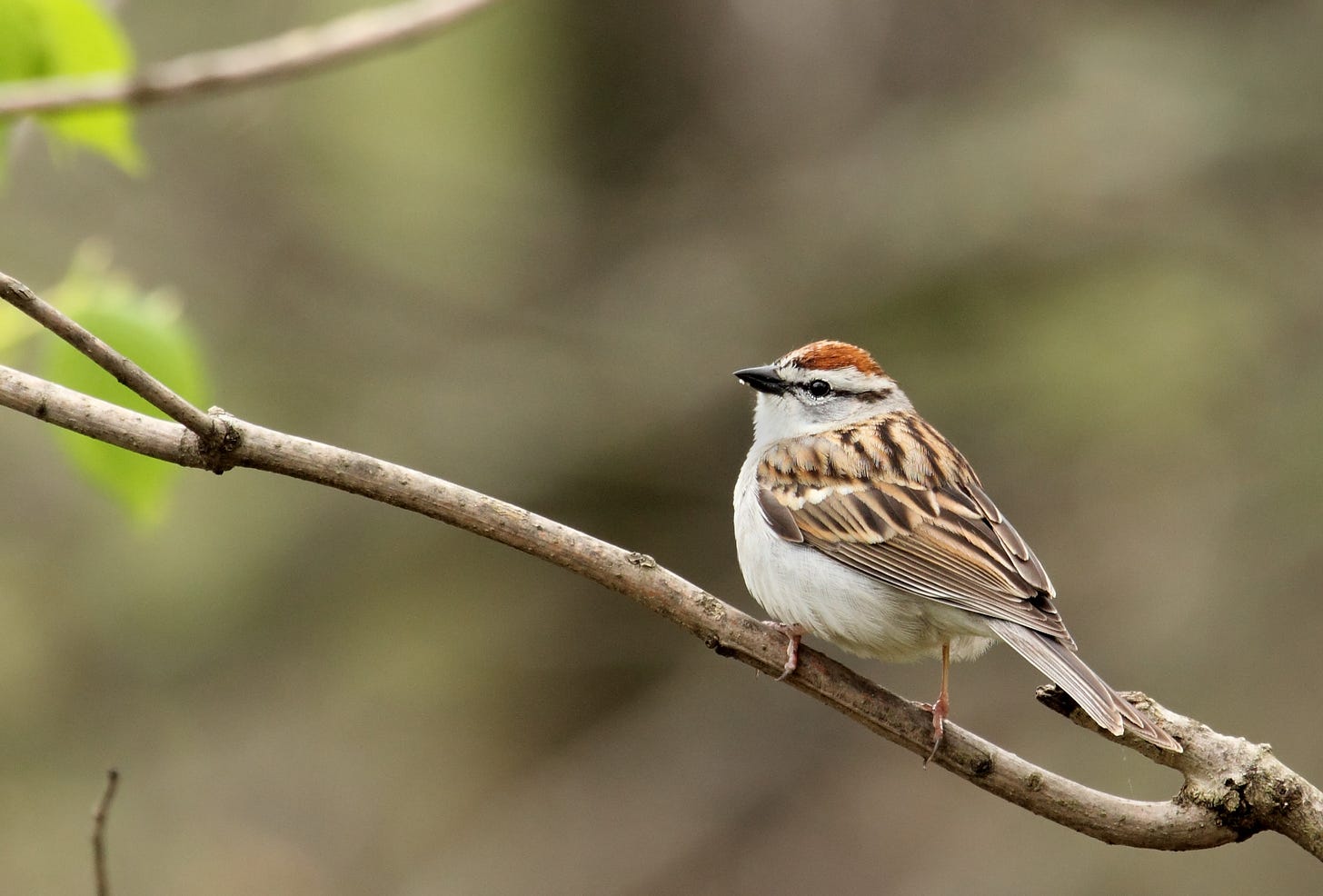
We’re also gonna deep listen for the what sound like drunk (slow, staccato) Robins. Could be a Rose-breasted Grosbeak or Baltimore Oriole.
And we’re of course gonna keep our eyes and ears out for early warblers like the Palm, Pine, Yellow-rumped, Ovenbird, Black-and-white, Northern Parula and Yellow Warblers. Speaking of whom—
THE 22 WARBLERS OF MCGOLRICK PARK
Silence except a whoosh of air. Day broken, sky-right, by the sun’s slow-opening eye.
You’ve flown all night to arrive over … North Brooklyn. Hunger and exhaustion urge descent. You do. Water and earth but … too much gray. Too much concrete. Not what inherited wisdom predicted. Not what the ancestors saw. Find whatever green—meaning bugs, meaning food, meaning life—remains. That tiny rectangle dotted by strange trees will have to do…
Beginning in late April, colorful songbirds smaller than sparrows, traveling from as faraway as S. America, towards Canada, will seek food in NYC’s parks (after flying all night!). Though there are 36 warblers who migrate across the eastern United States, 22 have been recorded in McGolrick. Let’s do our best to notice them.











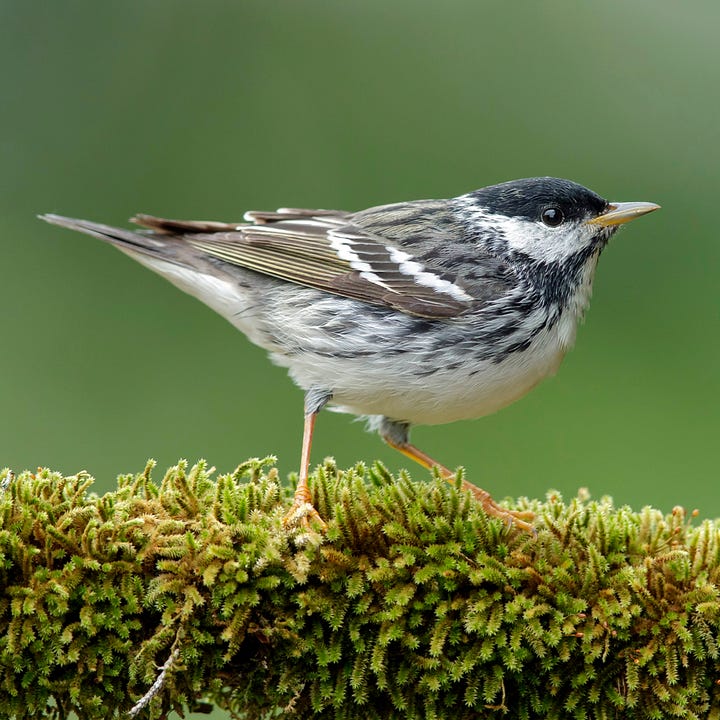










Reminder: IRL birds can differ from examples depending on time of year, sex, and whether or not they’re immature. Above photos feature breeding males—most common variant during Spring Migration. Suffice to say: non-breeding variants basically look like these birds but printed with less vibrant ink. Just memorize unique colors/patterns as best you can. All images licensed via Adobe Stock.
WELCOME TO THE RATHOLE
Days after Flaco the Owl died, friends at NBPA alerted us to tragedy at McCarren Park. One of its omnipresent Red-tailed Hawks was found near a planter, alive but unwell. A downed hawk is a rat poisoned hawk. Urban Park Rangers took the animal to the Wild Bird Fund, where anti-poisons would be administered. But the hawk died.
Two Greenpoint hawks dead in as many months? (First was a Cooper’s at 17 Diamond—the impetus for our glass-proofing effort). Bad news can paralyze, but also sublimate action. In that spirit, we dove headfirst down a Google rabbit rathole, to learn about rodenticides and alternatives. At hole’s bottom? Rat .. birth control?
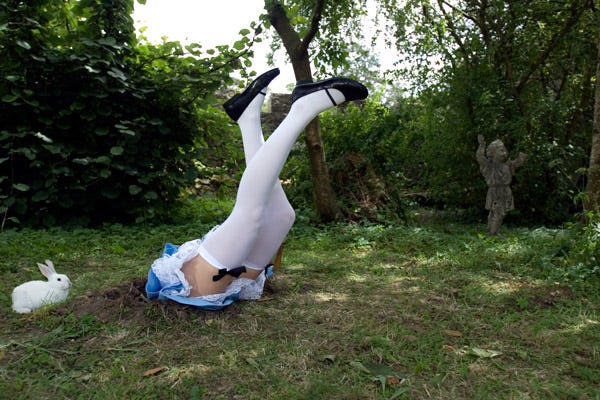
Did you know that rat poison is found in 84 percent of New York City’s dead birds of prey?* McCarren’s Red-tailed Hawk, just like Flaco, died prematurely because she dared to be a wild animal in our hood. (A toxicology report confirmed McCarren’s hawk was poisoned.) McCarren Park—like so much of New York City, including McGolrick**—is riddled with bait traps like these:

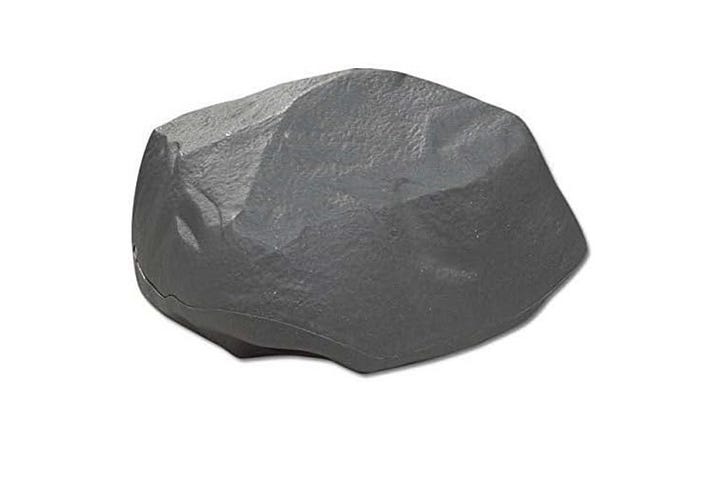
A BRIEF HISTORY OF RAT POISON
Birds of prey eat smaller animals; that’s their millions years-old evolutionary thing
Human settlements’ unprecedented uncleanliness attracts MANY small creatures, especially mice and rats
Man dislikes rodents that—checks notes—their own filthiness attracted
Instead of tidying up, Science Man invents “rat poison”
Only 50% of rodents who consume poison actually die
Birds of prey eat smaller—now poison-carrying—animals; millions years-old evolutionary thing is interrupted, perhaps permanently, by humans

QUESTIONS & ANSWERS
Q: Do we have to control vermin populations in the first place? A: Yes. A 2014 Columbia University study found that the average NYC subway rat carries dozens of pathogens, such as C difficile and hepatitis C, alongside 18 viruses previously unknown to science. W-T-F.
Q: Why are rats so numerous? A: Rats ain’t players but they crush a lot. Rat females reach sexual maturity at 9 weeks, have a short gestation period of 22 weeks, and can pop out a dozen pups per litter. The math means a pair of rats can make—wait for it—nearly 15,000 descendants in a year!
Q: Alternatives to poison? A: Much like Cesar Millan rehabilitates dog owners, not dogs; NYC Audubon urges fixes to problematic human behavior:
Keep all garbage and food in tightly sealed containers. Locking bins are best, as rats can easily tear through plastic trash bags.
Do not leave food for pets or other animals outside.
Remove standing water—fix leaky pipes and holes where water pools.
Remove dense vegetation from around and on buildings.
Seal openings to the building that are ½ inch or larger with stainless steel mesh and cement, or products designed specifically to exclude rodents.
If you still have rats, use non-chemical methods of control such as snap or electric traps. Audubon does not recommend the use of glue traps.
Q: If we followed Audubon’s guidelines, would they suffice? A: Yes, but media make that hard to know. Our information ecosystems are as polluted as our environmental ones. Attention grabbing, lazy, unserious headlines like “Rodenticide ban could be having unintended consequences: Pest control industry” abound, and make science-borne facts hard to find.***
Q: What else did you learn about? A: Rat birth control. Gothamist’s “Bryant Park tried to stop New York City rats from having babies. They failed”, besides remaking our headline point perfectly, presents an increasingly talked about non-lethal approach to rodents: birth control. The “study” mentioned, however, isn’t robust. It lasted only 1.5 months in accursed, trash dense—meaning many rat food alternatives to delicious birth control—Manhattan.
Q: Any good news? A: Yeah. Public outcry against ecosystem destroying rat poison has led to, besides inventions like rat birth control, rodenticide bans in places such as California and British Columbia. Even though these experiments have suffered from causation error laden media coverage, an increasingly informed + vocal public means more experimentation and regulation.
Q: What is the status quo in NYC? A. Poison. Though Eric Adams’s “Rat Czar” is savvy enough to be most vocal about poison-free interventions, rat poison still rules. Homeowners, without any regulation, can and do self-administer poison bait stations. Parks are peppered by them. Just look around. NYC Parks claims to limit rat poison use to October-March: “non-breeding seasons”. Little good that did McCarren’s hawk.
Q: Why can’t we have nice things? A: Because they require work. We hairless apes, especially the U-S-A varietal, are stupidly dismissive of maintenance work. We’re individualistic. We’re enchanted by marketing. We love go-it-alone, spritzy solutions. Don’t want to plug rat holes or keep your trash in tightly sealed containers, let alone coordinate such efforts with neighbors? Spray poison! Unseeable, secondary consequences be damned! (That’s us in ~140 chars.)

HOW DO WE HAVE NICE THINGS
Perhaps our hood can succeed where Bryant Park “failed”. We’re sniffing out opportunities to pilot rat birth control projects locally, and will holler if we need you. In the meantime, size your own building up. If appropriate, help your landlord follow NYC Audubon’s guidelines.
Go all squeaky wheel and call 3-1-1 (or the mayor’s office (212) 639-9675). Although these types of actions can feel futile, our reps treat the frequency of call types like performance metrics: annoyed residents mean lost votes. Say this:
In light of the death of Flaco the owl, and other dead birds of prey found in my neighborhood, I am calling to urge New York City to end the war on rats by prioritizing non-lethal strategies, like reforming waste management and disposal systems, making landscape modifications, and exploring rodent birth control options.
If you notice a property near your home baiting for rats, and you’re that kind of dudette or dude, kindly chat the poisoner up. Most folks don’t know the harm they do. NYC Audubon links to ready-to-print pdfs here, if that makes things easier. (We hold a few of those every Saturday. Just ask for one.)
If you’re unlucky enough to encounter a dead bird, log it at dBird.org. (You don’t have to know the species.)
If it’s a downed / disoriented, likely poisoned bird of prey, call the Urban Park Rangers at (718) 421-2021. They’ll try to take the bird to a lab, where anti-poison can be administered.
SOURCES & NOTES
*In retrospect, our mystical encounter with a Long-eared Owl perhaps wasn’t that mystical at all. The poor homie most likely fell onto a Russell Street trashcan because they were poisoned
**McGolrick Park’s exterminator(s) say they rely on carbon monoxide gas, a welcome alternative to rodenticides. That said, the bait stations are present
***In fairness to journalists trying to meet clickthrough quotas, if you actually read the aforementioned article you’ll notice attempts at truth. E.g., pest controllers acknowledge the dangers of rat poison. They, same as NYC Audubon, blame failures in human coordination as leading to rat networks that end up requiring tool-of-last-resort poison
https://www.theguardian.com/science/2016/sep/20/man-v-rat-war-could-the-long-war-soon-be-over
https://www.nycaudubon.org/our-work/conservation/urban-raptors/rodenticides
https://globalnews.ca/news/9613386/rodentcide-ban-more-rats-bc/
https://gothamist.com/news/they-tried-to-stop-new-york-city-rats-from-having-babies-they-failed
SHOUTOUTS
You did it.* The following hotties used data collection app eBird to log species they saw in McGolrick Park. As a result, we have baseline March data! Sarah Duford, Brittany Radocha, John Gaba, Jeremy Danneman, Parsley Steinweiss, Benjamin King, Julia Reinstein, Julia Scinto, Greg Thornberg, Kristen Bellomo, Monise Valente, Nate L-S, Christopher Chilton, Emily Diamond, Anna Kiley, David Meadows, Pierre Hills, Caroline Corwin, Sarah R, Loyan Beausoleil—you are hot. You did this:
See all of McGolrick’s bird likelihood charts here!





